I'm working on my next record attempt bird, and I'm going back to 29mm to see what I can do with an F10, the SSS, and the new Aerotech G80. I got some braided carbon sleeves, fiberglass sleeves, and carbon uni-directional tape from The Composite Store, and it was pretty cheap. By the way, they have a new product which is cured carbon trapezoids which should be perfect for fin edges: http://www.cstsales.com/carbon_te.html
Anyway, I'm doing an experiment with thin fins:

Each fin has a central layer of fine-weave FG surrounded on either side by unidirectional carbon tape. CTS apparently makes the carbon tape by squishing several strands of tow squished down to a uniform thickness and holding it together with a little bit of fine plastic mesh. As you can see, the pieces of tow don't always quite meet next to each other, but that's o.k., since unidirectional carbon isn't supposed to be strong in that direction, anyway. I pulled some of the tape apart to get the flat tow to outline the leading and outer edges of the fins. The fiberglass layer extends to the edges of the fins, which is about the only reason the fins are holding together in the picture. So far so good. The fins in the picture are 0.019" thick, and 0.4 grams each. I'll be thickening them up with more layers of uni tape, but I wanted to see how they would turn out with this much carbon first. I cured these in a vacuum bag between two pieces of floor tile marble ($2.50 each) from home depot. They're really flat and smooth, so they're perfect for this. Tomorrow after my carbon tube cures I'll do two or four more layers of uni tape that will extend all the way to the edges of the fins. After I mount them to the tube I'll do some microballoon-epoxy fillets, put more uni tape over the fin roots, and then do tip-to-tip with another layer of the thin FG.
The tube curing in the vacuum bag in the picture was tonight's project. I used 1.25" braided carbon fiber sleeve over a full-length 29mm cardboard tube from Apogee, and then wrapped it with one layer of my fine-weave FG. That CF sleeve was so easy, anyone could do it. And the materials were well under $10. The only expensive part was the 29-240 motor case inside the tube to keep it from getting crushed by the vacuum. But the braided sleeve pulled tight against the tube so well that I'm not sure I even needed the vacuum bag. It's like a Chinese finger puzzle when you pull the slack out of it.
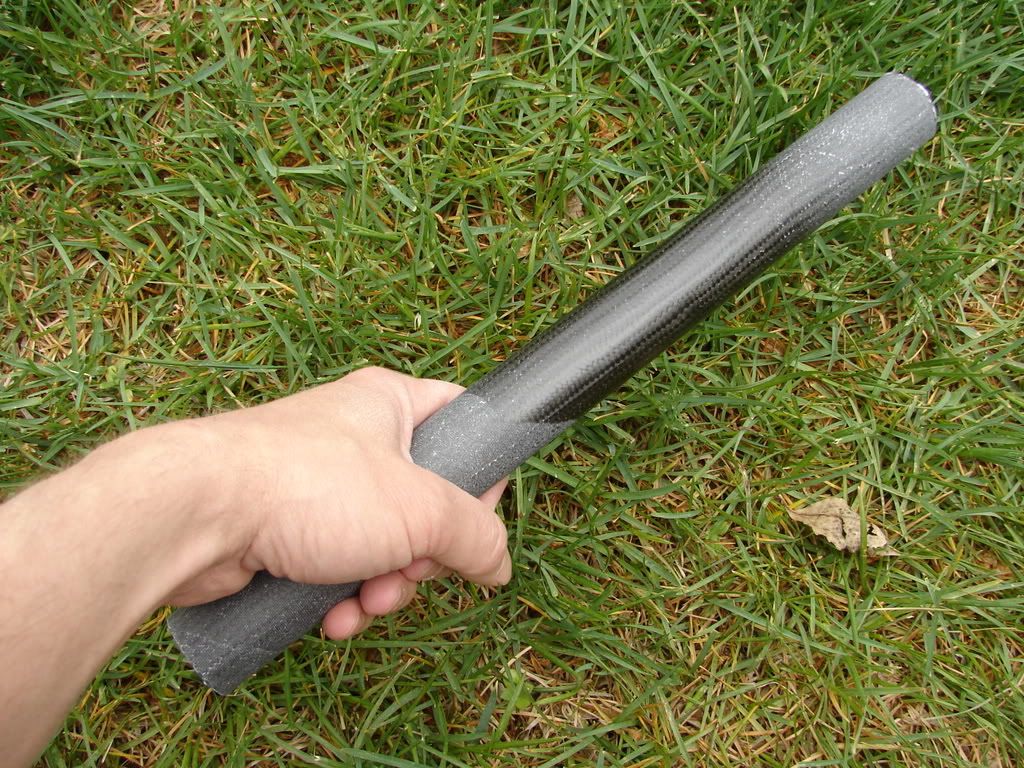
Here's the tube after it came out. I sanded it a bit and hit the middle part with some clear coat. It's almost 13" long, and 29 grams. It seems much stiffer and stronger than it needs to be. But I guess that means it's about right.
The diameter is 1.208, whereas a 29mm PML tube finished with fiberglass is 1.305. If I use this with a performance rocketry 29mm fiberglass cone, I should be able to sand off the bottom edge of the cone to make it flush. If I had done the layup right on the motor casing without using a cardboard tube for a mandrel, I probably could have gotten it a bit smaller, but I didn't want to stress about how to get the motor tube out when I was done.
The extra layer of unidirectional carbon brought the thickness up to 0.03 and the mass up to 0.8 grams each. They're amazingly stiff bending them as if they were attached to the airframe, but pretty flexible in the other direction. I'm thinking about adding another layer 90 deg to the one I just did before I stick them on the airframe to give them more resistance to twisting, and to make them a little thicker before the final tip-to-tip layer and fiberglassing. I'm tempted to skip that extra step, but I'd rather have these fins on the stronger side, and it only adds 0.01 in thickness. So it looks like when these are all done and glassed over on the bird they will be 50 mils thick near the tips, and about 60 mils near the root.
If you want to make another airframe I've got 24" or so of 29mm motor tube that I've been making 29mm cases out of. I wonder how much difference a 29mm 5:1 Von Karman nosecone would make 🙂
Edward
Thanks, Ed.
I'd like to take you up on that sometime, but probably not for a while, unless I lose this one right away. You'll probably have turned it into motors by then, but I'll contact you when the time comes.
Here's the avbay, Beeline side up:
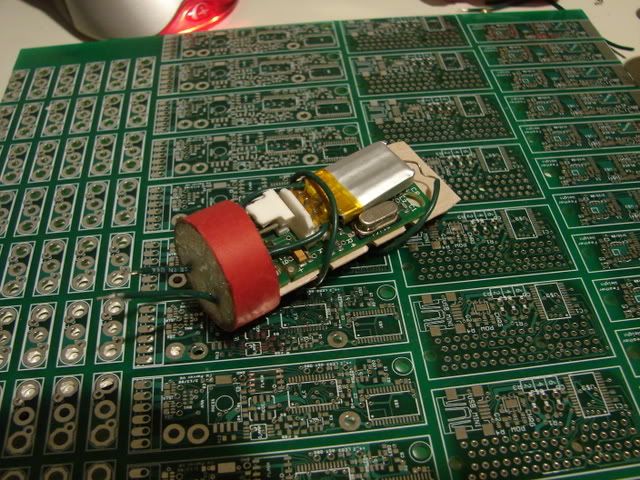
And Parrot side up: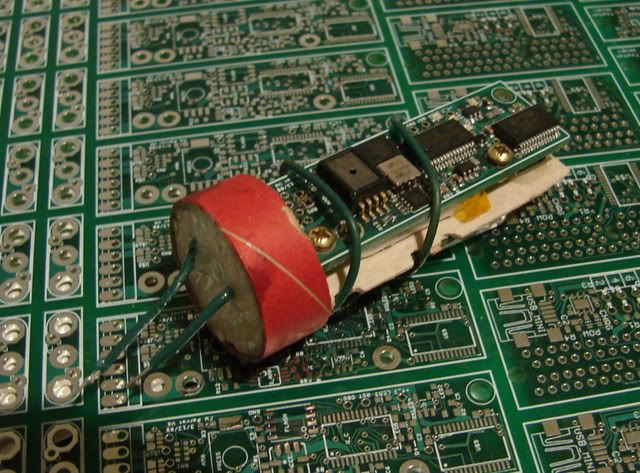
The avbay is 2.4 inches long. The helical wire is the Beeline's antenna. The Parrot will keep it off until apogee after the deployment charge has fired in order to eliminate interference.
I'll take that motor tube - I need a mandrel for making carbon tubing.
Warren
The fins are coming along. After some sanding they're 33 mils thick and 1.1 grams apiece.
Unidirectional carbon fiber is funny stuff. The fins are now very stiff in bending in the usual way fins bend, and they're also very stiff cross-wise, but they're still pretty of flexible when twisting torque is applied. Unfortunately, that sort of twisting is exactly what makes fins fail in fluttering. I'm realizing now that I didn't think through the forces and the stresses of fluttering very carefully. What I should have done is orient the fibers in +/- 45, rather than 0/90, in order to make the fins stiffer against twisting. They're stiff enough in general that I think I'll be o.k., especially if I do the final post-installation layers with the +/- 45 degree fiber orientation.
Actually, if I try to get clever about it I could try something that I read about NASA experimenting with, and that is orienting the fibers so that if the wind is pushing sideways on the fin, the fin twists in a way that reduces the angle of attack. This is similar to the anti-fluttering benefit that one would get by having the fins swept back, where pushing on the middle of the fin tip will angle the fin more into the wind.
Here's the latest status:
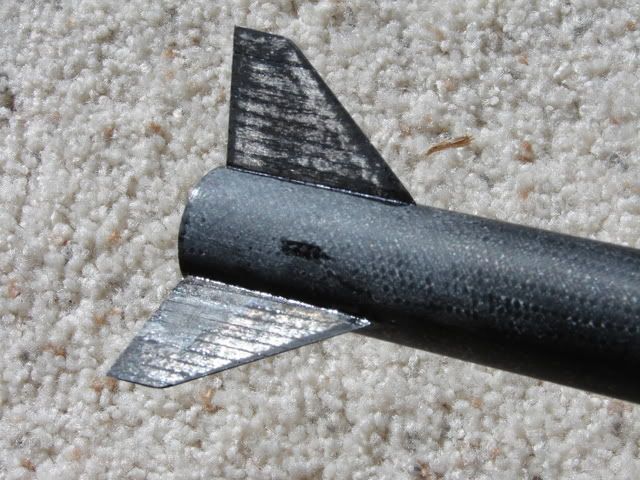
Next comes fillets and tip-to-tip unidirectional carbon. After thinking about it a bit, I believe that by orienting the fibers so that from the fin root the fibers are angled forward, that will make the fins twist in the direction that reduces the angle of attack when there is side pressure on them.
So far I've been happy with the layup quality using the marble floor tiles for pressure. The fins actually ring a little when dropped onto a hard surface.
Adrian,
Are you using peel ply and breather when you place the fins between the floor tiles or ????
Warren
Yes. I protect the floor tiles with a layer of thin plastic sheet, then one layer of blue shop towel, then a layer of pink fine-weave peel ply next to the wet layup. So far the shop towel has absorbed enough resin to get not-quite saturated.
The fillets are on now, and I've decided to finish building up the fins in one last layup: Each side of the fins will get one layer of 45 degree uni-directional carbon cut out in a patch that will just cover the fin and the fillet, one layer of 0 degree tip-to-tip uni CF, and then 1 or 2 layers of fine-weave FG at +/- 45 degrees, tip-to-tip. That should add quite a bit of stiffness and strength to the fins, which seem possibly stiff enough for supersonic flight but very fragile now at 0.033" thick. With the parts cut out for the last layup, I have gone through almost one package ($8 or something like that) of the 2" x 4' carbon uni tape from CTS.
Adrian,
I need you get get me up to speed on a couple of things.
The unidirectional carbon fiber, is it a tape - literal or a roll of flat cloth that looks like a roll of tape? Are you using epoxy resin for bonding or poly resin?
Next, the peel ply, what is that? How is it used and where does it come from?
I am going to pay a visit to CTS and try to get some idea of what everything is.....
I will be teaching a class for NCR club members on laying up composites, vacuum bagging, making composite airframes, fins, plate and related topics. (I don't do nosecones - you're on your own there).
The class will be limited to 8 people and will be held in August. Please contact me via PM to sign up. Cost will be minimal and will just cover materials used. Bring your own projects and we'll use them as the learning example.
Topics to be covered will include:
- Making airframes and glassing phenolic or paper tube
Making fins
Making solid composite plate for rings and bulkheads
Applying Tip to tip fabrics
Making fillets
Composite materials, peel-ply and release film, vacuum bagging materials
Cost is currently estimated to be about $25 and the class will be held on 3 or 4 successive Saturdays although I'm open to scheduling on weeknights as well.
Warren
Sounds like a good class, Warren.
Mule,
Here's a picture with some of the materials: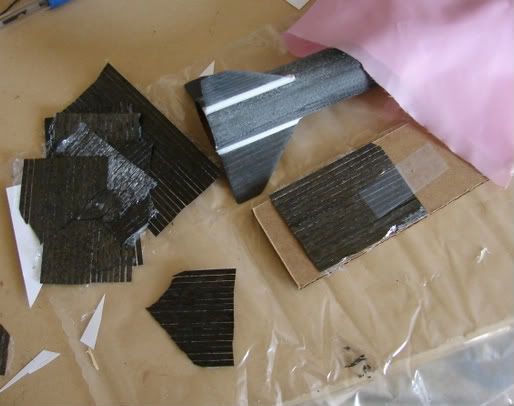
The unidirectional tape is dry, and comes rolled onto the cardboard rectangle. It started as a 4-foot roll, and you can see that not much is left of it. The pieces on the left are cut out to cover the fins and the fillet with the fibers at an angle. The pink cloth is the bleeder cloth. It's a fine-weave polyester, I think, with some sort of release coating on it.
I'm using epoxy resin. While it's possible to do a really small layup with 5-minute epoxy, laminating resin works better because of its lower viscosity and probably better properties. I ran out of the resin that I bought along with the bleeder cloth at a local fiberglass and plastic store, so I've been using some bob's hobby 1-to-1 fiberglassing epoxy I got at a hobby store. I haven't gotten around to buying a big thing of Aeropoxy, and this stuff was convenient, cheap and has been working well for me.
Thanks for the class Warren. I'll probably attend to catch mistakes I have taught myself. 😯
I plan on having my 29mm bird ready to fly for the next launch. The 38 is possible too, but not sure yet. I'm going to probably go mellow on the 29mm motor till I get a better nose cone for it.
I am going to try and paint the Vert Assault today so I can concentrate on the electronics. I could have 4 new rockets to try if I can keep at it.
Thanks for the pictures Adrian, I put in an order for several things from CTS today. That place is like a candy store for carbon. 😈
talk to you guys later.


